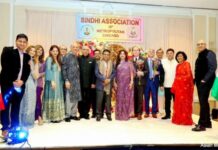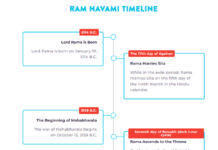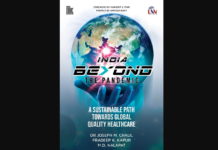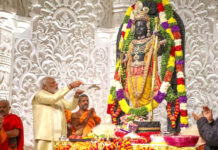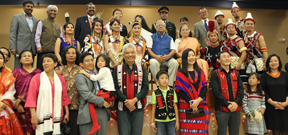 CHICAGO: Padmanabha Balakrishna Acharya, a recent appointee as Governor of Nagaland and Tripura, was in Chicago along with a troupe of tribal dancers from his State to create awareness about talents of Nagaland artists in USA and among Midwesterners.
CHICAGO: Padmanabha Balakrishna Acharya, a recent appointee as Governor of Nagaland and Tripura, was in Chicago along with a troupe of tribal dancers from his State to create awareness about talents of Nagaland artists in USA and among Midwesterners.
Acharya was in Chicago and a local organization Friends of India hosted a meet on Devon Avenue. Shridhar Damle was the coordinator along with Sohan Joshi, president of National Federation of Indian Associations.
Acharya, who is also Chairman of the North East Zone Cultural Center (NEZCC), lectured as the Chief Guest at Midwest workshops organized by International Center for Cultural Studies USA (ICCS) to highlight Native American life and facilitate interaction between indigenous peoples. The 13-member Nagaland Folkloric Group, drawn from different tribes, performed in Bloomington, Illinois, and in Canton, in Michigan.
NEZCC is one of seven regional centers established by Government of India to promote India’s traditional arts under the chairmanship of the Governor of the host state. ICCS mission is “to facilitate the revitalization of diverse ancient traditions and cultures of the world by fostering a forum for learning, understanding, and networking.”
Around 150 people attended the free gathering organized by ICCS Michigan chapter at Geneva Presbyterian Church in Canton, Michigan to honor local community leaders, who are working to encourage diversity and tolerance.
They included Steve Spreitzer from the Michigan Round Table, Michigan-based filmmaker Audery Geyer, Rev. Bryan Smith of Geneva Presbyterian Church, Anne Marie Hudak, South Indian classical dance teacher Sailaja Pullela and Naga dance group leader Theja Meru. Smith and Hudak are activists in the Plymouth Canton interfaith community outreach.
Among the Indian community leaders present were Padma Kuppa, Dr Yash Lakra, Roopal Shah, Arjun Surya and youth leaders Shantanu Deshmukh and Aneesha. Geyer’s documentary “Our Fires Still Burn: The Native American Experience,” which reflects on the historical trauma of the natives and presents their powerful and inspirational stories, was screened. In addition to the Naga cultural program, three local Indian-American teens performed a South Indian classical dance.
Acharya spoke in Hindi and English on India’s richly pluralistic traditions. He hails from Udupi district of Karnataka state, but has good command over Tulu, Kannada, besides Hindi and English.
The Governor distributed booklets he has authored or prefaced. Several tribal freedom fighters fought British rule but are unknown to mainland Indians. They include Rani Ma Gaidinlu of Nagaland, Dr. Daying Ering and Narottam of Arunachal Pradesh, Babu Jeebon Roy and U Tirot Singh of Meghalaya, and Joy Bhadra Hagjer of Assam. Others are on tribal festivals, proverbs, folk-tales and poems.
The Governor recounted his early involvement with the erstwhile North-East Frontier Agency (NEFA). There are now eight tribal states of Nagaland, Arunachal Pradesh, Manipur, Mizoram, Meghalaya, Assam, Sikkim and Tripura. They have borders that are 90 percent international and unfriendly, with many insurgent groups trained in Bangladesh and Myanmar.
The Modi government is bent on peace with these insurgent groups and India’s neighbors. Fresh water, soil, and minerals are abundant in NEFA, but there is no electricity despite abundance of hill-rivers. The prolonged insurgency has succeeded in uniting the independent tribes but these citizens are now tired of civil unrest and keen on development, he said.
Acharya said he preferred to focus on constructive initiatives. The Naga Diaspora is now spread all over the world with 20,000 in the U.S. alone. The Governor concluded by inviting all to visit Nagaland during the Hornbill festival in December.
Elizabeth Visuvalingam



